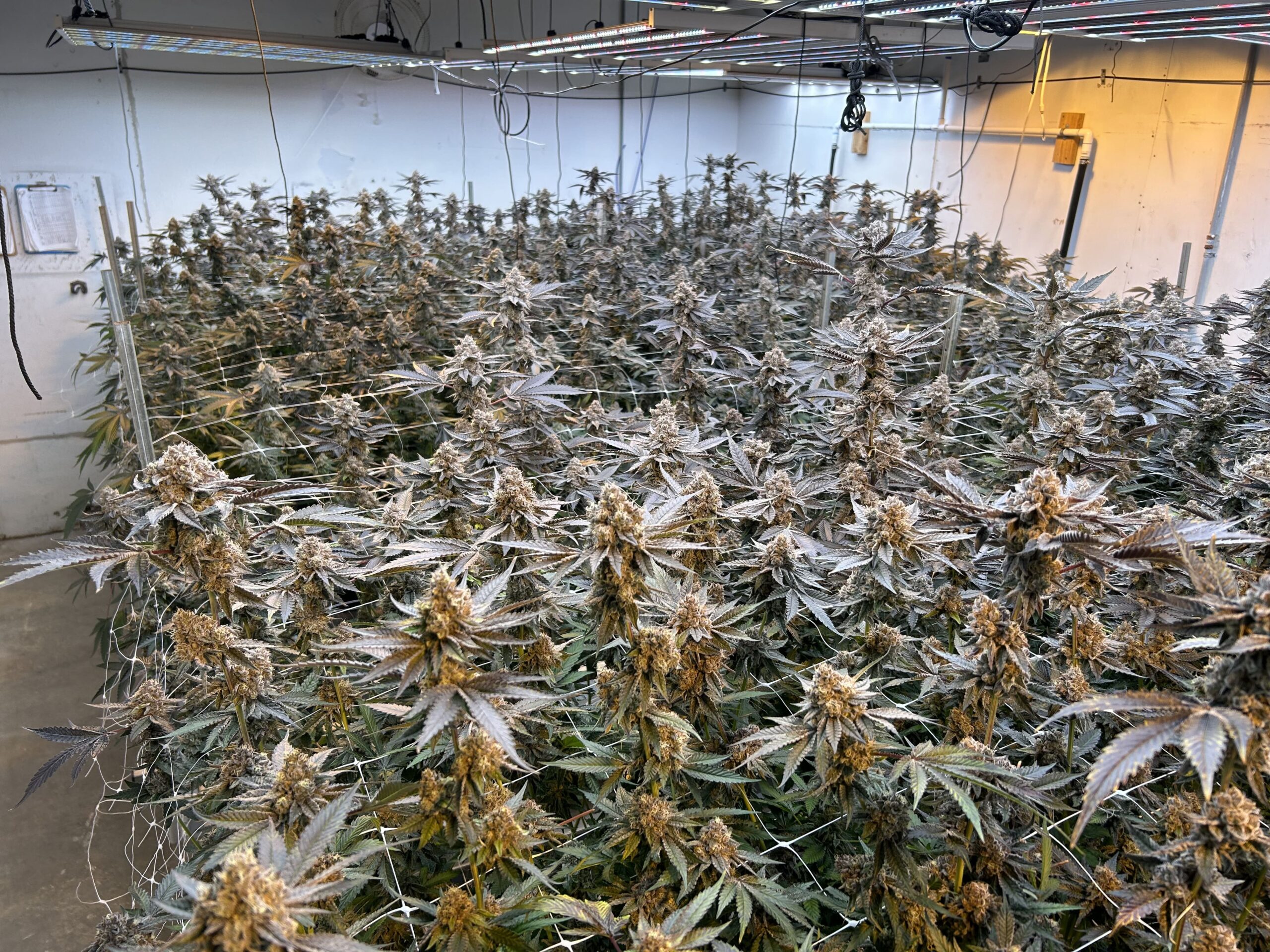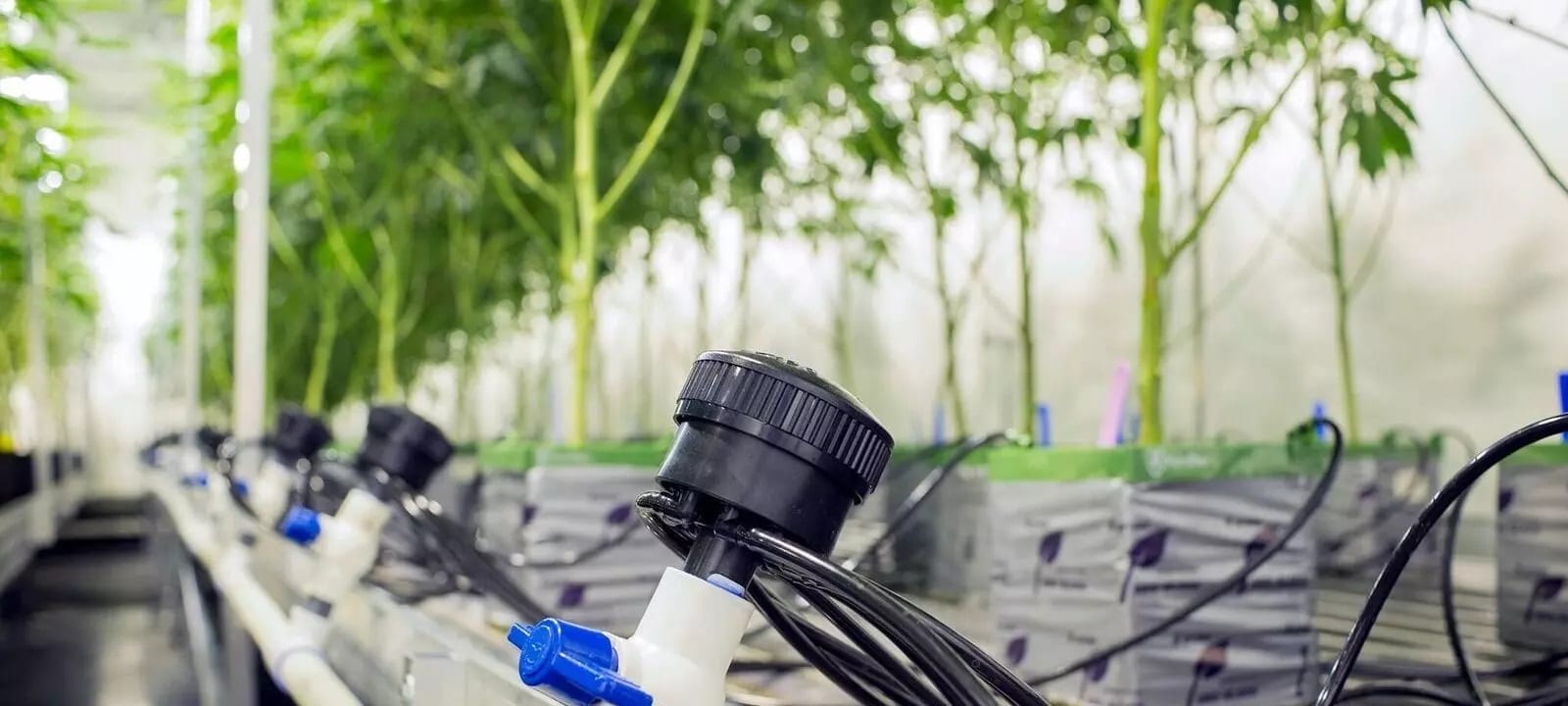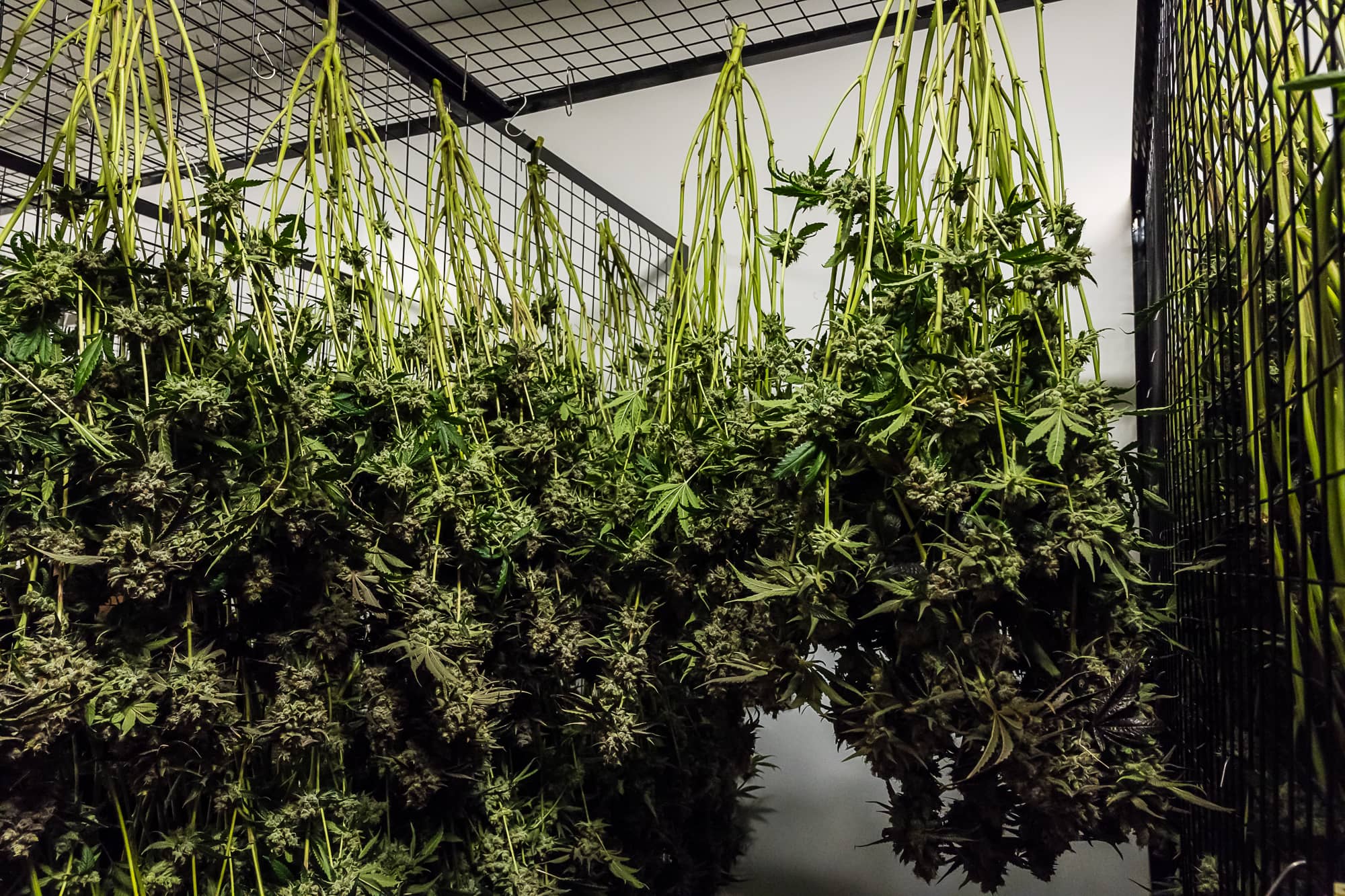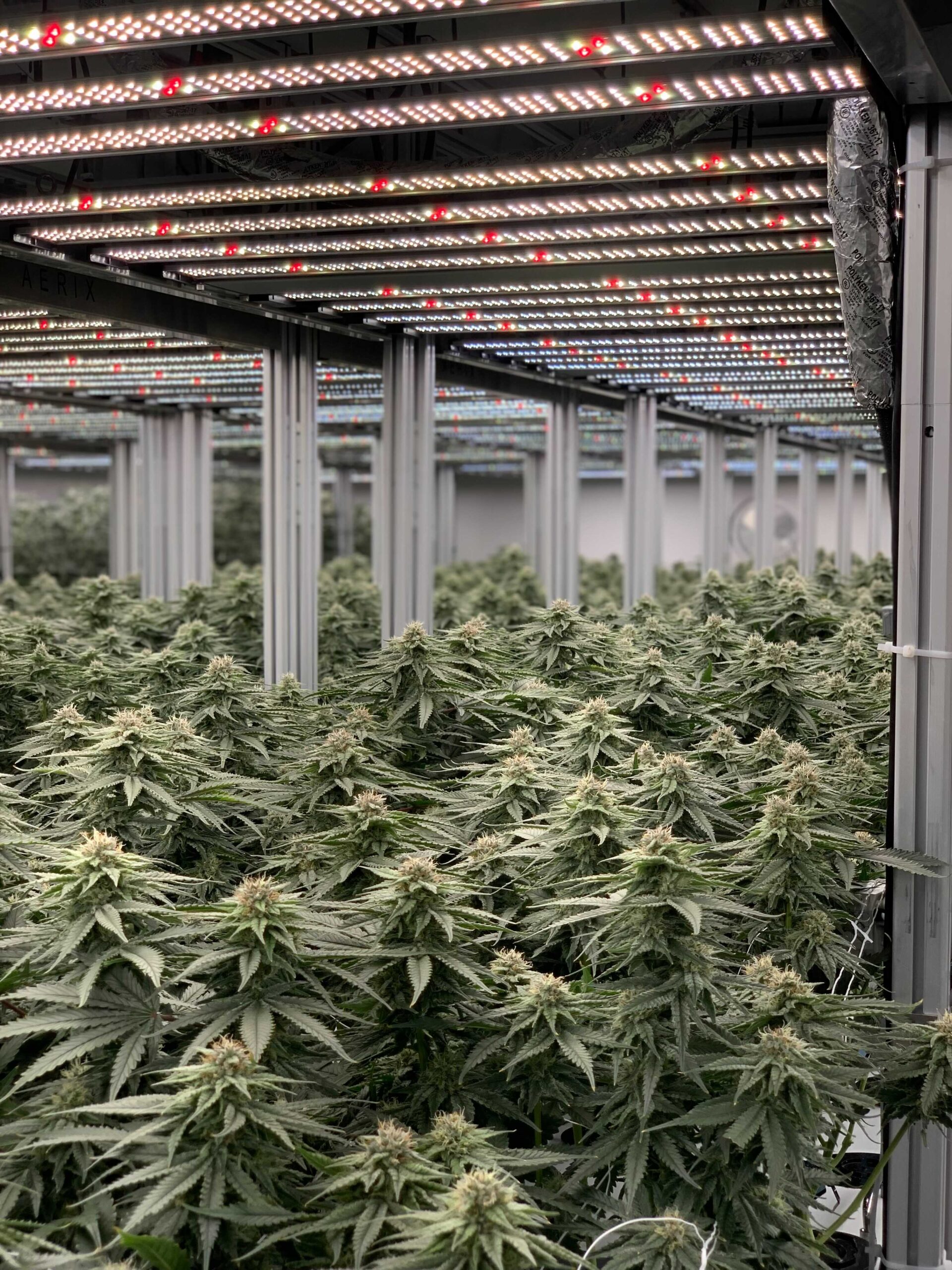Introduction to selecting the right cannabis software
Selecting a seed-to-sale solution is an important decision for any hemp or cannabis company.
Why? First, it takes a lot of resources to implement and adopt new software. Once a team is trained on one system, getting everyone to change is usually pretty hard. And costly! And second, the breadth of features one provider offers may differ greatly from another. What’s important for your company’s growth and objectives needs to drive the software selection decision.
So why not get it right the first time? Of course, there are times when your company’s needs may change. But, with a well-armed strategy for the research and selection process, you’ll have a better chance of selecting the right seed to sale software for your cannabis business.
What is cannabis software & why is it important for your business?
Cannabis software comes in many shapes and forms. The software allows a company to automate tasks or actions and increase operational efficiency. Cannabis software, when custom-built for cannabis operators, can bring even more efficiency by addressing the specific challenges of each unique license type.
As states continue to legalize cannabis across the country and markets mature, competition increases. In states where the cannabis industry has thrived for many years, like California or Colorado, profit margins become more important to track and raise. Cannabis software, though requiring investment and team training, allows a cannabis company to automate tasks and actions that constitute a large portion of labor costs.
Research Seed to Sale Software
In the software industry, there are well-respected review sites, like Capterra or G2, where one can browse and review software providers by their reviews. In our nascent industry, however, very few online reviews exist. This leaves software seekers looking for other ways to do their due diligence. Below are some alternative ways to discover and understand the cannabis software space.
Word of Mouth
For many people in the cannabis industry, much of the research is done via word of mouth. Facebook and LinkedIn have become great home bases for cannabis colleagues. Search the Facebook groups for your question, or start a new thread. We love the California – City & County Regulation Watch group. If you’re in a different state, you can find a more general or local group like this one. People in our industry are generally friendly and super helpful!
Online Directories
If you’re going to search online, aside from the standard Google search, you could try industry directories like MMJ Biz Daily and Cannabis Business Executive. You can review many company listings that link directly to their website. If you’re looking for software with experience in the cannabis space, this would be a good strategy.
Tradeshows and Events
Sometimes the best thing to do is get out and talk to people! Trade shows are fun and informal settings where you can meet with people working for different software companies. Not only can they help you uncover whether your pressing needs can be addressed by their software, but they can also answer general compliance or industry questions.
Events are also great for networking with others in the industry. You might meet a business owner like yourself who can recommend software they’ve tried or swear by. The cannabis community is all about sharing and helping each other grow. So don’t be afraid to reach out and ask for an opinion or some advice.
Metrc Seed to Sale Software Provider List
Another way to browse seed to sale solutions is to review the official list of Metrc-approved integrators. You can find Metrc’s list of validated and state-approved cannabis software vendors by going to their site, navigating to your state, and clicking on ‘Validated Software Providers.’ Here’s a screenshot showing the button in green where you’d click.
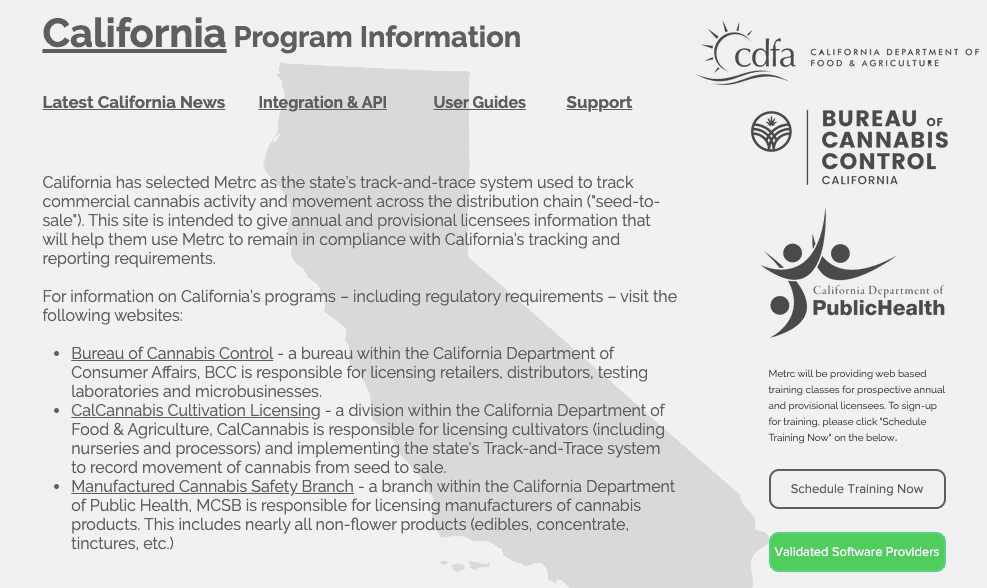
This gives you the full roster of cannabis software companies who have demonstrated their ability to report in real-time on specific Metrc functions related to their area of specialty (ie cannabis cultivator, cannabis retailer, etc.)
Some of the seed to sale tracking software on the list are very new and may not have any customers yet, so do your homework in your selection process to ensure you are selecting a reputable cannabis software provider.
Types of Cannabis Software
Enterprise Resource Planning (ERP)
We talked at great length about cannabis ERP systems in our collaborative article with RMCC (Rocky Mountain Cannabis Consulting).
What’s an ERP? In simple terms, it’s a software platform that combines many organizational systems, enhancing an organization’s efficiency. Some functions commonly found in ERPs include accounting, order management, inventory management, and human resources.
ERPs are typically employed at large, established organizations. There are some criticisms of an ERP platform, however. One is that they’re not nimble enough to keep up with regulatory and compliance changes. Others are that they’re too complex for most businesses, are rigid and expensive, or are difficult to implement and achieve full team adoption.
For some, cannabis ERPs make a lot of sense, so we don’t mean to discount them. The regulated industry is new, so cannabis seed to sale software should be evaluated on an as-needed basis. Will the software do everything you need, and will the implementation be easy? An ERP will surely spit out volumes of data, but if your team is unprepared to manage and use the data for a purpose, it might be more trouble than good.
Cannabis Seed to Sale Software
Cannabis regulations differ from state to state. The purpose of a seed-to-sale system is to track cannabis plants and cannabis products from seed all the way through the supply chain to when they’re sold to consumers. Traceability and compliance are important for every cannabis business in the supply chain.
Given that state-mandated seed to sale systems, like Metrc, often aren’t the most intuitive, many businesses choose to use a 3rd party cannabis software solution instead.
Cannabis software systems supporting entire supply chain activity, like GrowFlow and Flourish, are viable tools to manage business verticals and report to Metrc in real-time.
When evaluating seed to sale software, ask them about their approach to regulatory compliance and access to your data when needed. Audits, while infrequent, do happen, and you want to ensure that your platform offers quick access to inventory logs and associated documented activity.
Specialized Cannabis Software
A general solution might be a safe bet for some vertically integrated businesses. But for others, software tailored to their type of business might provide better functionality and, ultimately, value. Cannabis growers’ needs are worlds apart from a marijuana dispensary, delivery, or cannabis manufacturer, so it makes sense that each segment would require its own solution.
There are cannabis seed to sale systems tailored for all types of businesses. Some examples of customized software built for specific segments of the cannabis supply chain are:
- Cultivation: Trym
- Manufacturing: Backbone and Roshi
- Hardware: Growlink and TrolMaster
- Distribution: Distru
- Dispensary: Meadow | FlowHub | Greenbits | Treez
- Wholesale Platform: Confident Cannabis and Apex Trading
Cannabis CRM Software
Sales teams in the cannabis industry also need software! One of the most widely used cannabis-specific platforms is Cannabiz Media which provides current information on cannabis license data across the U.S. While Cannabiz Media is comprehensive, it’s not the most feature-rich software compared to other CRM software solutions.
The top desired CRM features include contact management, sales team, lead/opportunity management, reports and dashboards, sales analytics, a mobile app, email automation, and sales forecasting. Heavy hitters like Salesforce or Hubspot are commonly seen amongst larger organizations. And, of course, there are numerous cannabis-specific providers to choose from.
Any company in the cannabis industry can perform its own sales, whether wholesale to others in the supply chain or a cannabis retailer to its cannabis dispensary customers. However, some businesses naturally have a lot more customers than others.
For example, a marijuana dispensary requires a POS system (Point of Sale) to keep an active log of all interactions, important details about customers, and accurate inventory management. In a competitive space with decreasing margins, leaning on a POS and CRM software solution is crucial to keep customers returning and becoming loyal advocates.

The benefits of using cannabis software
Custom Workflows Boost Productivity
Recording information in a system may make a lot more sense when you use software developed to meet the demands of your specific sector and your company’s more localized needs. Much like there is always a proper tool for every task, there is frequently a specialized program for any given scenario.
Powerful Integrations
With a system built with your daily operations in mind, integrations to relevant software and hardware combine all the pieces into a central home base. Industry-specific integrations allow cannabis software providers to give users a better experience for their everyday activities.
A support team with answers
With a well-designed software system comes a focused support staff. Support employees who have received training in the cannabis industry are able to give good assistance and advice. In established cannabis software companies, the support team has amassed a wealth of knowledge on your specific niche and the challenges that come with it. At Trym, our support team is known for its Metrc expertise, often assisting customers with operational efficiency improvements.
Framework for Evaluating Software
Before you get down to the nitty-gritty of evaluating the tracking software, we recommend sitting down with your team and discussing a strategy for this process. A cannabis software solution should fit the business’s current needs, its scaling goals, and the pursuit of operational efficiency.
What Needs to be Improved?
Given that there are a lot of different tools out there, it can be easy to get lost and pulled in the wrong direction. There are cannabis and non-cannabis-focused software. Some providers went into business just to serve the cannabis and hemp industry, while other companies have a software offering in other industries that is rebranded as a cannabis software solution. There are also specific solutions for hemp businesses popping up.
Before you start scheduling a bunch of demos, thoughtfully answer these questions and discuss them with your team:
- What is driving your need for a new cannabis seed to sale platform?
- Do you have manual tasks that need to be automated with tracking software?
- Do you have processes in different departments that need to be consolidated?
Many cannabis businesses in the supply chain are developing their internal processes as they’re trying to scale. A cannabis manufacturer, for instance, might decide to incorporate various extraction techniques into their operation. Each new process must be built in parallel with the system that tracks it. And when you bring the topic of operational efficiency into the conversation, a cannabis manufacturer will require data analysis on their extraction processes to map profit margins and spot potential improvements.
You might address a specific problem like tracking operational data, predicting inventory, or seeking general improvements. Once you find your areas for improvement, you can convert them into short-term goals and objectives for each affected department.
Ensure Team Participation
If you don’t have executive buy-in, either financially or in the form of support, to integrate your new seed to sale software, this whole process can be a waste of time.
Get approval from the top first, followed by the directors of each department. A good practice is to list all the drawbacks of not using the software.
For example, say you’re seeking CRM software to support your operation. You can highlight the drawbacks of tracking data on old-fashioned spreadsheets and emails. Getting all employees’ support is also important, especially if you’ll change how people work daily.
Get an Outside Opinion
Let’s face it, we’re all working at startups. It can feel like a bubble sometimes when there’s more to deal with than you can name. But it’s important to know what the landscape of cannabis seed to sale software looks like if you’re in the market. You may be familiar with contractors and consultants in the medical marijuana industry, but have you spoken with one that focuses on technology and software platforms? Gather the data from all sources to help make a strategic decision.
Outsourcing support in this decision is not a bad idea. Getting guidance can supplement your internal expertise and help you make smarter, more informed decisions. We particularly recommend Rocky Mountain Cannabis Consulting (RMCC), which specializes in Metrc regulatory compliance and educates clients to help bring them up to speed.
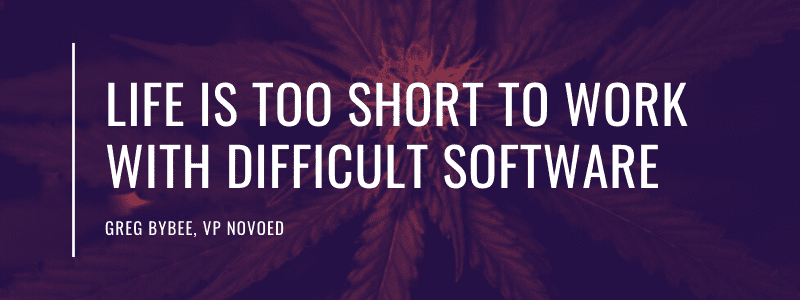
7 Decision Factors
When searching for the right cannabis tracking software, consider some important factors as you evaluate your options.
1. Functionality
Does the software do the bare minimum, or does it come with more features that facilitate more efficient operations? Better efficiency tends to minimize labor costs, which are the most expensive cog in your machine. Software should allow your current staff to do more and provide the infrastructure from which you can scale your business.
It’s also important to evaluate if the software will disrupt your current workflow and how. The goal is to free up employees’ time to focus on bigger things than data entry or paperwork. All new technical platforms require upfront time to set up and train.
This is also an area you should closely examine: is the invested extra time worth the benefits?
2. Customer Support
What happens when the software is great, but you don’t get the attention you need as a customer? You won’t be able to integrate the software into your company successfully. And worse, your team won’t know how to use it. Select a seed to sale software company that prides itself on its customer service, and you’ll ensure your money is well spent.
In a regulated market like cannabis, vendors that stay updated on current regulations can provide much greater value than those that don’t. You can easily find this out by asking them a few questions.
At Trym, we’re answering Metrc questions daily and helping solve customers’ challenges related to internal cannabis compliance and the use of our software. Our customers call us with their Metrc questions first. And our team is composed of folks who have worked with marijuana operations nationwide for years.
Be sure to interview the company and ask the hard questions. Customer service is crucial for software that works within a regulated industry.
3. Ease of Use
When selecting software, you need to remember who will be using it. Is it the IT department that’s technology-driven and doesn’t mind complex workflows? Or is it hourly workers who don’t use their computers for much more than checking email?
The harder the system is to use, the harder it will be to adopt. And the more time it will take for your team to use, which will cancel out the benefits you hoped you’d achieve.
“The harder the system is to use, the harder it will be to adopt.”
During the evaluation period, you’ll want to test drive the product with other decision-makers to ensure the software will create more value than a burden.
If the software is easy to use, your operation will benefit from increased efficiency. If it’s easy to learn, it will decrease the time needed to train the team and realize its value.
Seed to sale software with limited features might appear easier to use but can negatively impact your business later when you realize you’re unable to integrate processes and workflows like a fully-featured product would allow you to.
If you choose to accept it, your mission is to find the right balance of features and intuitiveness.
4. Credibility
In your investigations, ask about what companies are currently using their software. If a well-known cannabis cultivator or brand is on their roster, that’s a positive sign. It’s also good to look at similar companies, in nature and size, that have worked with the vendor in question.
Sometimes seed to sale vendors are willing to connect you to one of their customers who’s willing to speak about their experience. This is a great chance to ask the tough questions the vendor might be biased in answering directly.
Ultimately, you want to ensure your software provider won’t disappear off the face of the earth three months from now and that they have a good reputation in the marijuana industry.
5. Cost vs Value
You might think that cost is the most important factor when worrying about your bottom line. And it’s definitely up there in importance. However, we suggest evaluating software based on the value it brings to your cannabis business.
There are many apps out there that are very affordable yet don’t offer that much functionality. The value of these products is low. Why? Because it doesn’t save you time, help you make more money, or lower costs in your operation.
When evaluating software pricing with these things in mind, you may find that budgeting for something more expensive might make sense if it saves you x labor hours per month. Crunching the ROI on new cannabis software may be hard, but it will be worthwhile in the long run.
6. Enhancements
Agility is defined as the ability to move quickly and easily. In business, agility corresponds to innovation. Since many seed-to-sale software is custom-built for cannabis, innovation is inherent to these companies.
Other software companies are established in other industries. They’ve rebranded and adjusted their product for the marijuana industry. Generally, the larger a company, the less rapid innovation it’ll be able to do.
When researching, you could look at a company’s blog for signs of product improvements and updates. Ensure a vendor has a history of listening and addressing requests for changes or additions to the cannabis software. A great software partner will constantly be working to improve their software based on client feedback and requests.
Without updates, seed to sale software can quickly become outdated and irrelevant. A perfect solution today is not a perfect solution two years from now. Select a vendor who’s committed to regular enhancements.

7. Exit Strategy
When you’re getting quoted by a vendor, ask about the fine print. Some vendors require multi-year contract commitments. In a fast-paced industry like ours, where priorities and needs change often, contract lock-up might not be optimal.
Remember that many cannabis seed-to-sale software vendors will negotiate. All you have to do is ask! It’s always good to have a way out if, for some reason, you’re really unsatisfied. What if the features promised were not functional, the customer support was lackluster, or the software isn’t reporting to Metrc accurately in real-time? You want to have some flexibility to switch to a different vendor. For any reason.
Cultivating with Trym
We’ve introduced various ‘seed to sale’ software and the need for specialized solutions in the cannabis industry and all the unique license types within it. One of the best systems for cannabis growers is Trym, a cannabis farm management software custom-built for commercial growers.
Trym helps cannabis cultivators boost efficiency and consistency through precise environmental monitoring, customized task management, and data analytics. Unlike other seed-to-sale software in the cultivation space, Trym can tie in environmental data and track climate conditions along with plant growth and yields.
Trym is currently integrated with Metrc in California and Oregon and can be used alongside other marijuana compliance software in other states. To learn more about Trym’s cultivation software, contact us below!


